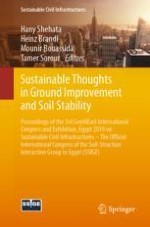2020 | OriginalPaper | Chapter
Application of Bottom Ash as Filter Material in Construction of Dyke Embankment for Sustainable Infrastructure
Author : Vinod Kumar Mauriya
Published in: Sustainable Thoughts in Ground Improvement and Soil Stability
Publisher: Springer International Publishing
Activate our intelligent search to find suitable subject content or patents.
Select sections of text to find matching patents with Artificial Intelligence. powered by
Select sections of text to find additional relevant content using AI-assisted search. powered by
